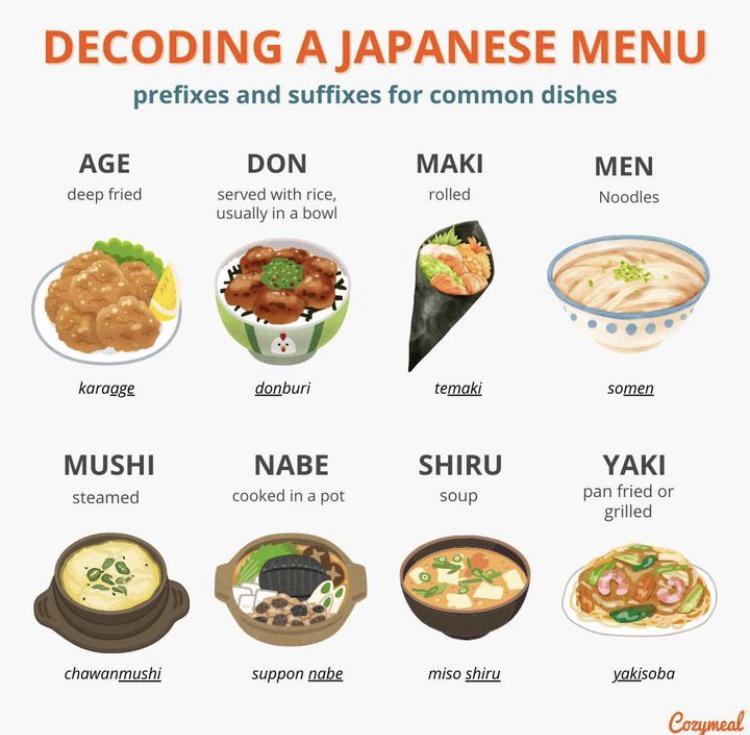Prefixes and suffixes for common Japanese dishes
« previous post | next post »
From Bored Panda (8/5/24). For people who love food and the culinary arts, this issue of Bored Panda, which has fifty parts, is almost like a bible.
Alas, no shime (see first item under "Selected readings" below, though nabe is mentioned in that post).
Selected readings
- "Phoshime" (8/7/24)
- "Chinese and Japanese Terms for Food Textures" (8/10/23)
- "Zo sashimi" (8/10/19)
[Thanks to Mark Metcalf]

Josh R. said,
August 13, 2024 @ 7:37 pm
"Don" is literally short for "donburi," so a dish that is [X]-don should *always* be served in some kind of bowl.
That said, I know that this cannot be assumed for Japanese menus outside Japan. Visiting a chain Japanese restaurant in the Twin Cities, I saw that they had "unadon", i.e., unagi donburi. I pictured this:
https://ja.wikipedia.org/wiki/%E9%B0%BB%E4%B8%BC#/media/%E3%83%95%E3%82%A1%E3%82%A4%E3%83%AB:Tokyo_Chikuyotei_Unadon01s2100.jpg
What I got was a plate of rice over which were laid thin, alternating strips of very dry unagi and pickled daikon. That was rough.
Graeme Orr said,
August 13, 2024 @ 9:13 pm
The Kenko Sushi House at my university serves everything – 'don' or not – in one of these plastic waxed cylindrical containers. https://wolt.com/en/aut/vienna/restaurant/kenko-bowls-sushirritos
Does this really count as a 'bowl'? Or is there another everyday Japanese word for it?
I'm always struck by how exacting traditional Japanese (food) culture is; alongside how modern Japanese life embraced plastics more than most.
Daniel Barkalow said,
August 15, 2024 @ 1:07 pm
The example for "maki" startled me, in a "Are they made with real Girl Scouts?" way. All of the other examples would be quite alarming attached to "te", but it's perfectly reasonable to have a "hand roll".
Josh R. said,
August 15, 2024 @ 7:19 pm
Graeme,
Those are sufficiently bowl-ish to fall under the "don" classification.
Tom said,
August 17, 2024 @ 3:14 am
"Yaki" is a difficult term. Yakisoba is soba noodles cooked on a griddle (like okonomiyaki), but yakitori is skewers of chicken grilled over an open flame. More confusing, toriyaki is when you are given pieces of raw chicken that you grill yourself on a small hibachi grill at your table. You would assume that this same self-cooking method with beef instead of chicken would be called nikuyaki, but it's called yakiniku.
Skewers that are deep-fried instead of grilled are called kushikatsu, even though grilled skewers are not called kushiyaki. My wife says katsu refers to the fact that the skewers are breaded, whereas "age" only means deep-fried. However, challenged to think of an "age" food that doesn't have breading of some kind, we can't. Further, age and katsu join tempura as words referring to breaded and fried foods. The words defy easy definition, although the foods are distinct and nobody would confuse a shrimp tempura with a shrimp kushikatsu.
Word combinations don't seem to follow a pattern. Temaki seems to refer to the fact that you hold the roll in your hand to eat it, not to the fact that it is rolled by hand. Saladamaki is a sushi roll with various components including lettuce, and tekamaki is a sushi roll with maguro (tuna) inside. Teka may refer to the red color of the tuna. Dashimaki is an egg dish, but egg doesn't feature in the name.
Incidentally, "zo" is elephant, so zo sashimi seems to refer to slices of raw.elephant, which might be good. Horse and whale are very edible.
Tom said,
August 17, 2024 @ 3:28 am
Also, udon is a famous noodle dish, although the name contains "don" and does not contain "men". And "nigiri sushi" is what we normally think of as sushi, but o-nigiri is a big ball of rice, often wrapped in seaweed. Finally, "genghis khan" is a grilled dish, and doesn't include any Mongolians. It is often advertised on English menus as including ram. In fact, it includes lamb.
unekdoud said,
August 18, 2024 @ 12:58 pm
"Tendon" always confuses my English-speaking brain for a bit.
Benjamin E. Orsatti said,
August 19, 2024 @ 7:58 am
You mean the Chinese menu isn't actually referring to connective tissue? Why hasn't anybody told me that in 45 years? I'd been mulling over how long you'd have to boil a tendon before it would be masticable. For want of a hyphen…